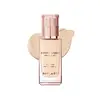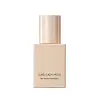What's inside
What's inside
 Key Ingredients
Key Ingredients

 Benefits
Benefits

 Concerns
Concerns

 Ingredients Side-by-side
Ingredients Side-by-side

Water
Skin ConditioningCyclopentasiloxane
EmollientTitanium Dioxide
Cosmetic ColorantTrimethylsiloxysilicate
EmollientButylene Glycol
HumectantIsododecane
EmollientDimethicone
EmollientPentylene Glycol
Skin ConditioningPEG/PPG-18/18 Dimethicone
EmulsifyingPEG-9 Polydimethylsiloxyethyl Dimethicone
EmulsifyingHydrolyzed Collagen
EmollientMagnesium Sulfate
Polyglyceryl-3 Diisostearate
EmulsifyingPolymethylsilsesquioxane
Tridecyl Trimellitate
EmollientTocopheryl Acetate
AntioxidantAluminum Hydroxide
EmollientTribehenin
EmollientDisteardimonium Hectorite
StabilisingPolypropylsilsesquioxane
Stearic Acid
CleansingTriethoxycaprylylsilane
Caprylyl Glycol
EmollientGlyceryl Caprylate
EmollientPropylene Carbonate
SolventPEG-10 Dimethicone
Skin Conditioning1,2-Hexanediol
Skin ConditioningXanthan Gum
EmulsifyingDisodium EDTA
Parfum
MaskingChromium Hydroxide Green
Ferric Chloride
AstringentFerrous Fumarate
Skin ConditioningWater, Cyclopentasiloxane, Titanium Dioxide, Trimethylsiloxysilicate, Butylene Glycol, Isododecane, Dimethicone, Pentylene Glycol, PEG/PPG-18/18 Dimethicone, PEG-9 Polydimethylsiloxyethyl Dimethicone, Hydrolyzed Collagen, Magnesium Sulfate, Polyglyceryl-3 Diisostearate, Polymethylsilsesquioxane, Tridecyl Trimellitate, Tocopheryl Acetate, Aluminum Hydroxide, Tribehenin, Disteardimonium Hectorite, Polypropylsilsesquioxane, Stearic Acid, Triethoxycaprylylsilane, Caprylyl Glycol, Glyceryl Caprylate, Propylene Carbonate, PEG-10 Dimethicone, 1,2-Hexanediol, Xanthan Gum, Disodium EDTA, Parfum, Chromium Hydroxide Green, Ferric Chloride, Ferrous Fumarate
Water
Skin ConditioningDiphenylsiloxy Phenyl Trimethicone
Skin ConditioningCyclopentasiloxane
EmollientCyclohexasiloxane
EmollientTitanium Dioxide
Cosmetic ColorantTriethoxycaprylylsilane
Aluminum Hydroxide
EmollientHomosalate
Skin ConditioningEthylhexyl Salicylate
UV AbsorberLauryl PEG-8 Dimethicone
Alcohol Denat.
AntimicrobialGlycerin
HumectantButylene Glycol
HumectantIsododecane
EmollientAcrylates/Polytrimethylsiloxymethacrylate Copolymer
Skin ConditioningTrimethylsiloxysilicate
EmollientDimethicone/Vinyl Dimethicone Crosspolymer
Skin ConditioningPhenyl Trimethicone
Skin ConditioningPolymethylsilsesquioxane
CI 77891
Cosmetic ColorantPolyglyceryl-4 Isostearate
EmulsifyingPolypropylsilsesquioxane
1,2-Hexanediol
Skin ConditioningSodium Hyaluronate
HumectantDisteardimonium Hectorite
StabilisingCaprylyl Methicone
Skin ConditioningDimethicone
EmollientDimethicone/PEG-10/15 Crosspolymer
Dipropylene Glycol
HumectantSodium Citrate
BufferingTocopherol
AntioxidantIron Oxides
CI 77492
Cosmetic ColorantMagnesium Sulfate
Sorbitan Sesquioleate
EmulsifyingCaprylyl Glycol
EmollientCI 77491
Cosmetic ColorantEthylhexylglycerin
Skin ConditioningParfum
MaskingCitronellol
PerfumingLinalool
PerfumingGeraniol
PerfumingCI 77499
Cosmetic ColorantSilica Dimethyl Silylate
EmollientSilica
AbrasiveTin Oxide
AbrasiveWater, Diphenylsiloxy Phenyl Trimethicone, Cyclopentasiloxane, Cyclohexasiloxane, Titanium Dioxide, Triethoxycaprylylsilane, Aluminum Hydroxide, Homosalate, Ethylhexyl Salicylate, Lauryl PEG-8 Dimethicone, Alcohol Denat., Glycerin, Butylene Glycol, Isododecane, Acrylates/Polytrimethylsiloxymethacrylate Copolymer, Trimethylsiloxysilicate, Dimethicone/Vinyl Dimethicone Crosspolymer, Phenyl Trimethicone, Polymethylsilsesquioxane, CI 77891, Polyglyceryl-4 Isostearate, Polypropylsilsesquioxane, 1,2-Hexanediol, Sodium Hyaluronate, Disteardimonium Hectorite, Caprylyl Methicone, Dimethicone, Dimethicone/PEG-10/15 Crosspolymer, Dipropylene Glycol, Sodium Citrate, Tocopherol, Iron Oxides, CI 77492, Magnesium Sulfate, Sorbitan Sesquioleate, Caprylyl Glycol, CI 77491, Ethylhexylglycerin, Parfum, Citronellol, Linalool, Geraniol, CI 77499, Silica Dimethyl Silylate, Silica, Tin Oxide
Ingredients Explained
These ingredients are found in both products.
Ingredients higher up in an ingredient list are typically present in a larger amount.
1,2-Hexanediol is a synthetic liquid and another multi-functional powerhouse.
It is a:
- Humectant, drawing moisture into the skin
- Emollient, helping to soften skin
- Solvent, dispersing and stabilizing formulas
- Preservative booster, enhancing the antimicrobial activity of other preservatives
Aluminum Hydroxide is a form of aluminum. It can be naturally found in nature as the mineral gibbsite. In cosmetics, Aluminum Hydroxide is used as a colorant, pH adjuster, and absorbent.
As a colorant, Aluminum Hydroxide may add opacity, or reduce the transparency. Aluminum hydroxide is contains both basic and acidic properties.
According to manufacturers, this ingredient is an emollient and humectant. This means it helps hydrate the skin.
In medicine, this ingredient is used to help relieve heartburn and help heal ulcers.
There is currently no credible scientific evidence linking aluminum hydroxide in cosmetics to increased cancer risk.
Major health organizations allow the use of aluminum hydroxide in personal care products and have not flagged it as a carcinogenic risk at typical usage levels.
Learn more about Aluminum HydroxideButylene Glycol (or BG) is used within cosmetic products for a few different reasons:
Overall, Butylene Glycol is a safe and well-rounded ingredient that works well with other ingredients.
Though this ingredient works well with most skin types, some people with sensitive skin may experience a reaction such as allergic rashes, closed comedones, or itchiness.
Learn more about Butylene GlycolCaprylyl Glycol is a humectant and emollient, meaning it attracts and preserves moisture.
It is a common ingredient in many products, especially those designed to hydrate skin. The primary benefits are retaining moisture, skin softening, and promoting a healthy skin barrier.
Though Caprylyl Glycol is an alcohol derived from fatty acids, it is not the kind that can dry out skin.
This ingredient is also used as a preservative to extend the life of products. It has slight antimicrobial properties.
Learn more about Caprylyl GlycolCyclopentasiloxane, or D5, is a silicone used to improve texture of products and trap moisture.
D5 is considered lightweight and volatile. Volatile means it evaporates quickly after application. Once evaporated, D5 leaves a thin barrier that helps keep skin hydrated.
It is also an emollient. Emollients help soften the skin and prevent water loss. Silicones create a silky texture in products. D5 helps other ingredients become more spreadable.
Studies show D5 is safe to use in skincare products. We recommend speaking with a skincare professional if you have concerns.
Learn more about CyclopentasiloxaneDimethicone is a type of synthetic silicone created from natural materials such as quartz.
What it does:
Dimethicone comes in different viscosities:
Depending on the viscosity, dimethicone has different properties.
Ingredients lists don't always show which type is used, so we recommend reaching out to the brand if you have questions about the viscosity.
This ingredient is unlikely to cause irritation because it does not get absorbed into skin. However, people with silicone allergies should be careful about using this ingredient.
Note: Dimethicone may contribute to pilling. This is because it is not oil or water soluble, so pilling may occur when layered with products. When mixed with heavy oils in a formula, the outcome is also quite greasy.
Learn more about DimethiconeDisteardimonium Hectorite comes from the clay mineral named hectorite. It is used to add thickness to a product.
It can also help stabilize a product by helping to disperse other ingredients.
Hectorite is a rare, white clay mineral.
Learn more about Disteardimonium HectoriteIsododecane is a fragrance, emollient, and solvent.
As an emollient, it helps your skin stay soft and hydrated. Emollients help trap moisture into your skin.
Isododecane's role as a solvent makes it a great texture enhancer. It spreads smoothly on skin and does not leave a sticky feeling behind. Isododecane also helps prevent color transfer in makeup products.
Isododecane is not absorbed into skin.
Learn more about IsododecaneMagnesium Sulfate is a salt. More specifically, it is an epsom salt, or the bath salt used to help relieve muscle aches.
Despite having ‘sulfate’ in the name, it isn’t a surfactant or cleansing agent like sodium lauryl sulfate. Unlike those sulfates, magnesium sulfate doesn’t have the same cleansing or foaming properties (it's simply a type of salt).
In cosmetics, Magnesium Sulfate is used to thicken a product or help dilute other solids. It is a non-reactive and non-irritating ingredient.
One study shows magnesium deficiency may lead to inflammation of the skin. Applying magnesium topically may help reduce inflammation.
You can find this ingredient in sea water or mineral deposits.
Learn more about Magnesium SulfateParfum is a catch-all term for an ingredient or more that is used to give a scent to products.
Also called "fragrance", this ingredient can be a blend of hundreds of chemicals or plant oils. This means every product with "fragrance" or "parfum" in the ingredients list is a different mixture.
For instance, Habanolide is a proprietary trade name for a specific aroma chemical. When used as a fragrance ingredient in cosmetics, most aroma chemicals fall under the broad labeling category of “FRAGRANCE” or “PARFUM” according to EU and US regulations.
The term 'parfum' or 'fragrance' is not regulated in many countries. In many cases, it is up to the brand to define this term.
For instance, many brands choose to label themselves as "fragrance-free" because they are not using synthetic fragrances. However, their products may still contain ingredients such as essential oils that are considered a fragrance by INCI standards.
One example is Calendula flower extract. Calendula is an essential oil that still imparts a scent or 'fragrance'.
Depending on the blend, the ingredients in the mixture can cause allergies and sensitivities on the skin. Some ingredients that are known EU allergens include linalool and citronellol.
Parfum can also be used to mask or cover an unpleasant scent.
The bottom line is: not all fragrances/parfum/ingredients are created equally. If you are worried about fragrances, we recommend taking a closer look at an ingredient. And of course, we always recommend speaking with a professional.
Learn more about ParfumPolymethylsilsesquioxane is a silicone used as a film forming agent.
When applied to the skin, this ingredient creates an invisible film on the surface. This film still allows oxygen to pass through, but prevents moisture from escaping. This can help condition and hydrate the skin. It also leaves a silky feel when applied.
Polymethylsilsesquioxane has not been shown to clog pores. It has been deemed safe to use up to 55%, but most cosmetics use much less.
If you have concerns about using this ingredient, we recommend speaking with a professional.
Learn more about PolymethylsilsesquioxanePolypropylsilsesquioxane is a synthetic silicone resin used to create a flexible, water-resistant layer on the skin or hair.
This helps improve the wear and transfer resistance in products like foundations, sunscreens, and colored makeup without feeling greasy.
Titanium dioxide is a mineral UV filter widely used in sunscreens and cosmetics.
It is one of only two UV filters officially classified as “mineral” by regulatory agencies, the other being zinc oxide.
Titanium dioxide provides broad-spectrum protection mostly in the UVB and UVAII range, with some protection in the UVAI range.
While its UVA protection isn’t as strong as zinc oxide’s, the difference is minor.
A common myth is that mineral UV filters reflect UV light. However, modern research shows titanium dioxide absorbs UV radiation like chemical filters (~95% absorption & 5% reflection).
Thanks to its non-irritating nature, titanium dioxide is suitable for sensitive, acne-prone, or redness-prone skin. It is unlikely to cause "eye sting" like other sunscreen ingredients.
A major drawback of this ingredient is its white cast and thick texture. This is why mineral sunscreens often leave a white cast and are less cosmetically elegant than chemical/hybrid sunscreens.
To improve white cast and spreadability, micronized or nano-sized titanium dioxide is often used.
There are ongoing concerns surrounding nano-titanium oxide's impact on marine ecosystems.
There is no conclusive evidence that any form of titanium oxide (or any other sunscreen ingredients) will cause harm to marine ecosystems or coral reefs. The science is still developing but many consumers are keeping a close eye on this issue.
Please note, many destinations have reef-safety sunscreen rules. For instance, the U.S. Virgin Islands advises all visitors to use non-nano mineral sunscreens.
Nano mineral sunscreens once raised safety concerns about absorption into skin.
Extensive research has shown that they do not penetrate healthy or damaged skin; they remain safely on the surface and the top layer of dead skin (stratum corneum).
You'll likely find titanium dioxide bundled with alumina, silica, or dimethicone. These ingredients help make titanium dioxide highly photostable; this prevents it from interacting with other formula components under UV light.
Learn more about Titanium DioxideTriethoxycaprylylsilane is a silicone used to bind and stabilize ingredients.
As an emulsifier, it helps prevent ingredients from separating. This can help elongate the shelf life of products.
Triethoxycaprylylsilane is often used to coat mineral sunscreens ingredients to help give a better feel. It also helps reduce oxidative stress in sunscreens.
Learn more about TriethoxycaprylylsilaneThis silicone is an emollient. Emollients create a thin film on the skin to prevent moisture from escaping.
It is not soluble in water and helps increase water-resistance in products.
According to a manufacturer, it can blend seamlessly with silicone oils, such as Cyclopentasiloxane.
Learn more about TrimethylsiloxysilicateWater. It's the most common cosmetic ingredient of all. You'll usually see it at the top of ingredient lists, meaning that it makes up the largest part of the product.
So why is it so popular? Water most often acts as a solvent - this means that it helps dissolve other ingredients into the formulation.
You'll also recognize water as that liquid we all need to stay alive. If you see this, drink a glass of water. Stay hydrated!
Learn more about Water